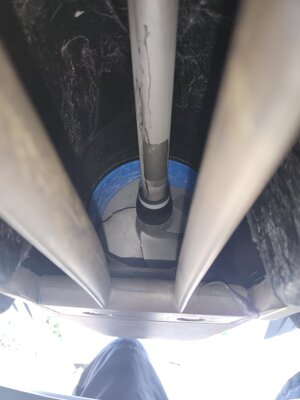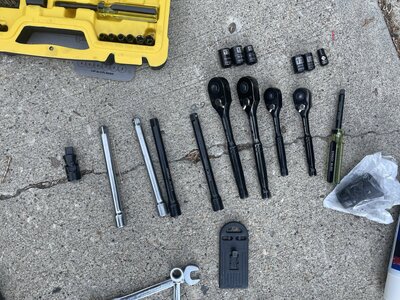The fact that your machine is new, and the picture you shared, I can tell from the look of your impeller blades that you sucked up enough rocks (it doesn't take much) to ding the leading edge of the blades up nicely, and that has very likely also caused similar impact to your blue plastic cylinder surrounding your impeller, as seen in your photo. This blue cylinder is called a wear ring, and it's name tells you what it's for. Instead of ruining the tunnel, the wear ring takes the hit, and is much cheaper to replace. It's a $100 part here in Canada, cheaper in the US. Some people replace the plastic wear ring with stainless steel ones that can take more abuse, but this isn't without it's problems too - more damage can be done to the impeller - which are many times the cost of the plastic wear ring - as well as things can be more jammed with rocks/debris between metal and metal, instead of between metal and plastic, making it harder to clear a jam and install new parts.
Grooves cut into the wear ring by the same rocks that dinged up that impeller are the majority of the problem causing your lack of thrust / speed. As Burner71 above implies, the grooves cut into the plastic wear ring by rocks eliminate your tight tolerances between your impeller and wear ring - so your impeller can't "hook up" to the water properly and give you normal thrust/speed. The reason you can get 10 mph out of it is because there is still some level of "traction" that your impeller can manage in that imperfect tunnel, but not much. BGS above mentions you can feel vibration when you have this condition. Vibration will be minor at low revs, and you will manage low cruising speed, but when you add more RPM, all you get is cavitation, typically with stronger vibration you can feel and hear, instead of increased forward thrust. Keep the revs down - high RPMS won't help you get anywhere faster, burns more gas, and more importantly, vibration/cavitation over time can lead to other problems (worn carbon rings, etc.).
While a bummer, the good news is that when this happens you can at least usually get the machine back to the launch (slowly, with low revs), unless things get totally jammed up.
You can expect that your dealer will want to change that impeller as well as the blue wear ring, and then things will be almost 100% again. You can save money on labour and do this job yourself with the right tools (you will need an impeller tool to replace the impeller, and on some models you need to remove the impeller to replace the wear ring. Buy the right marine grease and thread-locker to protect your investment.
For example, on my 2022 Spark Trixx, I don't need to remove the impeller to replace my wear ring, but I do need to remove the impeller to replace the wear ring on my 2023 GTX 230 (ask me how I know, lol). Don't know the design for your 170 Switch, but it might be similar to my 230 GTX, which means the impeller has to come off, and it's better to put the new wear ring in the freezer to shrink it a bit before pounding it into place inside the outer metal sleeve on the pump housing, and this necessary tight fit also makes getting the ruined wear ring out from the pump housing a bit harder, but still not that complicated - people use utility knives or torches to either cut or heat/fold the plastic ring so it can easily come out.
Above I do say "almost 100%". This is because you have likely also caused some degree of damage (hopefully minor) to the "stator veins" that are located aft of the impeller. These are metal fins that are molded into the pump housing directly behind the impeller, and work to cancel the spin of the water being pumped out by the impeller (to stop your machine from leaning to one side, and also to improve thrust).
If the damage to the stator veins are slight, you'll be fine, but in my case with my 2022 Spark Trixx, my initial unwillingness to never start my new machines in less than 2.5-3 feet of water meant I was sucking up rocks 3 times in only one year on that poor Trixx, which not only necessitated new wear rings every time, and even though I ground the impeller blades sharp again to reduce cavitation after each incident, this takes the impeller out of balance, is never 100%, and eventually I needed to put in a new impeller as it was past fixing, and even the pump housing needed to be replaced because the stator veins were too mangled.
I took the opportunity to make lemonade from this self-induced damage though, and upgraded the programming (engine tune) from a reputable Canadian dealer on the 90HP engine to 120 and had him ship me a Solas racing impeller and pump (no more mangled stator veins) with the tablet that he used to upgrade my tune over wi-fi, and the machine is now WAY better than new - I call it the FrankenSPARK (got a jump on the 2024 Spark X! - although I suspect tuners will be able to do much more with the Spark X if they really do cram a 1600 ACE into the Spark next year and de-tune it to "just" 120-130HP to minimize lawsuits from inexperienced riders), and you can imagine with this investment I'm being WAY more careful about avoiding shallow water now. Like many people, I needed to learn the hard way, through the school of hard Rocks, and finally have accepted that these machines (including the Switch) are basically giant vacuum cleaners for rocks, and if you don't respect that fact, it'll cost you in down time and dollars.
Watch some YouTube videos on replacing impellers and wear rings to get an idea of how this is done. 3 Feet Deep is an excellent channel for PWC's, which will give you the basic idea for your switch, and I'm sure you'll also find similar videos for this work on your same watercraft, so you can find out EXACTLY how it's done with your 170HP machine.
If you feel the above is over your head, just let the dealership slap in the new impeller and wear ring. It will only take them 1-3 hours and you'll have your machine back fast (unless the parts are on backorder!).
Good luck and blue skis!
Russ
Below after grinding out the dings in my stock Spark Impeller in 2022 - you can see a bit of the stator veins in the pump housing directly behind the impeller - and yes, there is damage to the veins that only got worse each time I sucked up rocks.
View attachment 63488







